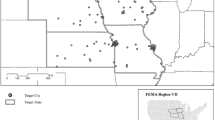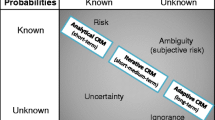Abstract
Climate change brings uncertain risks of climate-related natural hazards. The US Federal Emergency Management Agency (FEMA in Climate change: long-term trends and their implications for emergency management, 2011. https://www.fema.gov/pdf/about/programs/oppa/climate_change_paper.pdf) has issued a policy directive to integrate climate change adaptation actions into hazard mitigation programs, policies, and plans. However, to date there has been no comprehensive empirical study to examine the extent to which climate change issues are integrated into state hazard mitigation plans (SHMPs). This study develops 18 indicators to examine the extent of climate change considerations in the 50 SHMPs. The results demonstrate that these SHMPs treat climate change issues in an uneven fashion, with large variations present among the 50 states. The overall plan quality for climate change considerations was sustained at an intermediate level with regard to climate change-related awareness, analysis, and actions. The findings confirm that climate change concepts and historic extreme events have been well recognized by the majority of SHMPs. Even though they are not specific to climate change, mitigation and adaptation strategies that can help reduce climate change risks have been adopted in these plans. However, the plans still lack a detailed assessment of climate change and more incentives for collaboration strategies beyond working with emergency management agencies.





Similar content being viewed by others
References
Babcock M (2013) State hazard mitigation plans and climate change: rating the states. Columbia Law School Center for Climate Change Law, November, 2013
Baker I, Peterson A, Brown G et al (2012) Local government response to the impacts of climate change: an evaluation of local climate adaptation plans. Landsc Urban Plan 107(2):127–136
Baynham M, Stevens M (2014) Are we planning effectively for climate change. An evaluation of official community plans in British Columbia. J Environ Plan Manag 57(4):557–587
Berke PR (1996) Enhancing plan quality: evaluating the role of state planning mandates for natural hazard mitigation. J Environ Plan Manag 39(1):79–96
Berke P, Lyles W (2013) Public risks and the challenges to climate-change adaptation: a proposed framework for planning in the age of uncertainty. Cityscape 15(1):181–208
Berke P, Song Y, Stevens M (2009) Integrating hazard mitigation into new urban and conventional developments. J Plan Educ Res 28:441–455
Berke P, Smith G, Lyles W (2012) Planning for resiliency: evaluation of state hazard mitigation plans under the disaster mitigation act. Nat Hazards Rev 13(2):139–149
Bierbaum R, Smith JB, Lee A et al (2013) A comprehensive review of climate adaptation in the United States: more than before, but less than needed. Mitig Adapt Strateg Glob Change 18(3):361–406
Bierbaum R, Lee A, Smith J, Blair M, Carter LM, Chapin FS, Fleming III P, Ruffo S, McNeeley S, Stults M, Verduzco L, Seyller E (2014) Chapter. 28: Adaptation. In: Melillo JM, Richmond TTC, Yohe GW (eds) Climate change impacts in the United States: the third national climate assessment. U.S. Global Change Research Program, pp 670–706
Brody SD (2003) Implementing the principles of ecosystem management through local comprehensive land use planning. Popul Environ 24:511–540
Burby RJ, May PJ (1997) Making governments plan: state experiments in managing land use. JHU Press, Baltimore
Burch S (2010) Transforming barriers into enablers of action on climate change: insights from three municipal case studies in British Columbia, Canada. Glob Environ Change 20(2):287–297
Carmin J, Nadkarni N, Rhie C (2012) Progress and challenges in urban climate adaptation planning. Results of a global survey. Massachusetts Institute of Technology (MIT), Cambridge
Carter JG, Cavan G, Connely A, Guy S, Handley J, Kazmierczak A (2015) Climate change and the city: building capacity for urban adaptation. Prog Plan 95:1–66
Clarke L, Edmonds J, Jacoby H, Pitcher H, Reilly J, Richels R (2007) Scenarios of Greenhouse Gas Emissions and Atmospheric Concentrations. Sub-report 2.1A of Synthesis and Assessment Product 2.1 by the U.S. Climate Change Science Program and the Subcommittee on Global Change Research. Department of Energy, Office of Biological & Environmental Research, Washington, DC, USA, 154 pp
Eakin HC, Patt A (2011) Are adaptation studies effective, and what can enhance their practical impact. Wiley Interdiscip Rev Clim Change 2(2):141–153
Eisenack K, Moser SC, Hoffmann E et al (2014) Explaining and overcoming barriers to climate change adaptation. Nat Clim Change 4(10):867–872
Ellis F, Allison E (2004) Livelihood diversification and natural resource access: Food and Agriculture Organization of the United Nations. Livelihood Support Programme (LSP). An inter-departmental programme for improving support for enhancing livelihoods of the rural poor. Evidence from Southern Ethiopia. Quart J Int Agric 43:209–267
FEMA (Federal Emergency Management Agency) (2011) Climate change: long term trends and their implications for emergency management. https://www.fema.gov/pdf/about/programs/oppa/climate_change_paper.pdf. Accessed 01 Mar 2017
FEMA (Federal Emergency Management Agency) (2012) FEMA climate change adaptation policy statement. https://www.fema.gov/media-library-data/20130726-1919-25045-6267/signed_climate_change_policy_statement.pdf. Accessed 01 Mar 2017
FEMA (Federal Emergency Management Agency) (2015) State mitigation plan review guide. https://www.fema.gov/media-library-data/1425915308555-aba3a873bc5f1140f7320d1ebebd18c6/State_Mitigation_Plan_Review_Guide_2015.pdf. Accessed 01 Mar 2017
Field CB (2012) Managing the risks of extreme events and disasters to advance climate change adaptation: special report of the intergovernmental panel on climate change. Cambridge University Press, Cambridge. https://www.ipcc.ch/pdf/special-reports/srex/SREX_Full_Report.pdf
Fu X, Tang Z (2013) Planning for drought-resilient communities: an evaluation of local comprehensive plans in the fastest growing counties in the US. Cities 32:60–69
Fu X, Gomaa M, Deng Y et al (2017) Adaptation planning for sea level rise: a study of US coastal cities. J Environ Plan Manag 60(2):249–265
Gasper R, Blohm A, Ruth M (2011) Social and economic impacts of climate change on the urban environment. Curr Opinion Environ Sustain 3(3):150–157
Godschalk DR, Rose A, Mittler E et al (2009) Estimating the value of foresight: aggregate analysis of natural hazard mitigation benefits and costs. J Environ Plan Manag 52(6):739–756
Hamin EM (2011) Integrating adaptation and mitigation in local climate change planning. University of Massachusetts-Amherst. https://works.bepress.com/elisabeth_hamin/8/. Accessed 01 Mar 2017
Hansen L, Gregg R, Arroyo V et al (2015) The state of adaptation in the United States: an overview. A report for the John D. and Catherine T. MacArthur Foundation. http://www.ecoadapt.org/data/library-documents/TheStateofAdaptationintheUnitedStates2013.pdf
Horney J, Nguyen M, Salvesen D et al (2016) Assessing the quality of rural hazard mitigation plans in the Southeastern United States. J Plan Educ Res 0739456X16628605
Hurd BH, Coonrod J (2008) Climate change and its implications for New Mexico’s water resources and economic opportunities. NM State University, Agricultural Experiment Station, Cooperative Extension Service, College of Agriculture and Home Economics
IPCC (Intergovernmental Panel on Climate Change) (2014) Climate change 2014—impacts, adaptation and vulnerability: regional aspects. Cambridge University Press. http://www.ipcc.ch/report/ar5/wg2/
Jacoby HD, Janetos AC, Birdsey R, Buizer J, Calvin K, de la Chesnaye F, Schimel D, Wing IS, Detchon R, Edmonds J, Russell L, West J (2014) Chapter. 27: mitigation. In: Melillo JM, Richmond TTC, Yohe GW (eds) Climate change impacts in the United States: the third national climate assessment. U.S. Global Change Research Program, pp 648–669. https://doi.org/10.7930/J0C8276J
Kareiva P, Enquist C, Johnson A et al (2008) Synthesis and conclusions. In: Preliminary review of adaptation options for climate-sensitive ecosystems and resources, pp 622–689
Kousky C, Olmstead SM, Walls MA et al (2013) Strategically placing green infrastructure: cost-effective land conservation in the floodplain. Environ Sci Technol 47(8):3563–3570
Lavell A, Oppenheimer M, Diop C et al (2012) Climate change: new dimensions in disaster risk, exposure, vulnerability, and resilience. https://www.ipcc.ch/pdf/special-reports/srex/SREX-Chap1_FINAL.pdf. Accessed 01 Mar 2017
Lempert RJ, Collins MT (2007) Managing the risk of uncertain threshold responses: comparison of robust, optimum, and precautionary approaches. Risk Anal 27(4):1009–1026
McDonald L, Allen W, Benedict M et al (2005) Green infrastructure plan evaluation frameworks. J Conserv Plan 1(1):12–43
Means E, Laugier M, Daw J et al (2010) Decision support planning methods: incorporating climate change uncertainties into water planning. Water Utility Climate Alliance White Paper. https://www.amwa.net/galleries/climate-change/WUCA_decisionsupportplanningJan10.pdf
Measham TG, Preston BL, Smith TF et al (2011) Adapting to climate change through local municipal planning: barriers and challenges. Mitig Adapt Strateg Glob Change 16(8):889–909
Melillo JM, Richmond T, Yohe G (2014) Climate change impacts in the United States. Third national climate assessment. U.S. Global Change Research Program. https://doi.org/10.7930/j0z31wj2
Morgan MG (2009) Best practice approaches for characterizing, communicating and incorporating scientific uncertainty in climate decision making. DIANE publishing, Collingdale
Moser SC, Luers AL (2008) Managing climate risks in California: the need to engage resource managers for successful adaptation to change. Clim Change 87:309–322
Nelson AC, French SP (2002) Plan quality and mitigating damage from natural disasters: a case study of the Northridge earthquake with planning policy considerations. J Am Plan As 68(2):194–207
NOAA (National Oceanic and Atmospheric Administration) (2012) Achieving hazard-resilience: costal and waterfront smart growth and hazard mitigation roundtable report. https://www.epa.gov/sites/production/files/documents/epa-noaa_hazard_resilience.pdf. Accessed 01 Mar 2017
Parson EA, Burkett V, Fisher-Vanden K, Keith D, Mearns L, Pitcher H, Rosenzweig C, Webster M (2007) Global-change scenarios: their development and use. US Department of Energy Publications. http://digitalcommons.unl.edu/usdoepub/7. Accessed 01 Mar 2017
Picketts IM, Curry J, Rapaport E (2012) Community adaptation to climate change: environmental planners’ knowledge and experiences in British Columbia, Canada. J Environ Policy Plan 14(2):119–137
Preston BL, Westaway RM, Yuen EJ (2011) Climate adaptation planning in practice: an evaluation of adaptation plans from three developed nations. Mitig Adapt Strateg Glob Change 16(4):407–438
Renn O (2011) The social amplification/attenuation of risk framework: application to climate change. Wiley Interdiscip Rev Clim Change 2(2):154–169
Schwab J (2010) Hazard mitigation: integrating best practices into planning (PAS 560). American Planning Association, PAS, Chicago
Shen S (2014) An integrated approach to coastal community’s vulnerability analysis—case study in Tampa Bay region, Ph.D. dissertation, University of Florida, Gainesville, FL
Snover A, Binder L, Kay J et al (2007) Preparing for climate change: a guidebook for local, regional, and state governments. Environ Health Perspect 117(4):617–623
Srivastava R, Laurian L (2006) Natural hazard mitigation in local comprehensive plans: the case of flood, wildfire and drought planning in Arizona. Disaster Prev Manag Int J 15(3):461–483
Stevens MR, Lyles W, Berke PR (2014) Measuring and reporting intercoder reliability in plan quality evaluation research. J Plan Educ Res 34(1):77–93
Stone B, Vargo J, Habeeb D (2012) Managing climate change in cities: will climate action plans work. Landsc Urban Plan 107(3):263–271
Tang Z (2008) Evaluating local coastal zone land use planning capacities in California. Ocean Coast Manag 51(7):544–555
Tang Z, Brody SD, Quinn C et al (2010) Moving from agenda to action: evaluating local climate change action plans. J Environ Plan Manag 53(1):41–62
Tang Z, Dai Z, Fu X et al (2013) Content analysis for the US coastal states’ climate action plans in managing the risks of extreme climate events and disasters. Ocean Coast Manag 80:46–54
U.S. Department of Homeland Security (DHS) (2009) FEMA’s progress in all-hazards mitigation, Office of Inspector General. U.S. Department of Homeland Security, Washington, DC, p 20528
Wheeler SM (2008) State and municipal climate change plans: the first generation. J Am Plan As 74(4):481–496
Woodruff SC, Stults M (2016) Numerous strategies but limited implementation guidance in US local adaptation plans. Nat Clim Change 6:796–802
Author information
Authors and Affiliations
Corresponding author
Rights and permissions
About this article
Cite this article
Hu, Q., Tang, Z., Zhang, L. et al. Evaluating climate change adaptation efforts on the US 50 states’ hazard mitigation plans. Nat Hazards 92, 783–804 (2018). https://doi.org/10.1007/s11069-018-3225-z
Received:
Accepted:
Published:
Issue Date:
DOI: https://doi.org/10.1007/s11069-018-3225-z




